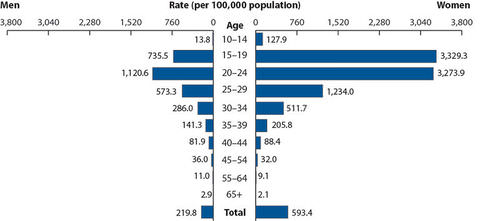11.76: STIs
- Page ID
- 14422

What is safe sex?
Safe sex is sexual activity engaged in by people who have taken precautions to protect themselves against sexually transmitted infections. Abstaining from sexual activity, however, is the only way to be absolutely sure that you won't get a sexually transmitted infection.
Sexually Transmitted Infections
A sexually transmitted infection (STI) is an infection that spreads through sexual contact. STIs are caused by pathogens, a living thing or virus that causes infection. The pathogens enter the body through the reproductive organs. Many STIs also spread through body fluids, such as blood. For example, a shared tattoo needle is one way an STI could spread. Some STIs can also spread from a mother to her baby during childbirth.
STIs are more common in teens and young adults than in older people. One reason is that young people are more likely to take risks. They also may not know how STIs spread. They are likely to believe myths about STIs (Table below).
| Myth | Fact |
|---|---|
| If you are sexually active with just one person, you can’t get STIs. | The only way to avoid the risk of STIs is to practice abstinence from sexual activity. |
| If you don’t have any symptoms, then you don’t have an STI. | Many STIs do not cause symptoms, especially in females. |
| Getting STIs is no big deal, because STIs can be cured with medicine. | Only some STIs can be cured with medicine; other STIs cannot be cured. |
Most STIs are caused by bacteria or viruses. STIs caused by bacteria usually can be cured with drugs called antibiotics. But antibiotics are not effective against viruses. Therefore, STIs caused by viruses are not treated with antibiotics. Other drugs may be used to help control the symptoms of viral STIs, but they cannot be cured. Once you have a viral STI, you are usually infected for life.
Bacterial STIs
In the U.S., chlamydia is the most common STI caused by bacteria. Females are more likely than males to develop the infection. Rates of chlamydia among U.S. females in 2006 are shown below (Figure below). Rates were much higher in teens and young women than in other age groups.
Chlamydia may cause a burning feeling during urination. It may also cause a discharge (leaking of fluids) from the vagina or penis. But in many cases it causes no symptoms. As a result, people do not know they are infected, so they don’t go to the doctor for help. If chlamydia goes untreated, it may cause more serious problems in females. It may cause infections of the uterus, fallopian tubes, or ovaries. These infections may leave a woman unable to have children.

Gonorrhea is another common STI. Gonorrhea may cause pain during urination. It may also cause a discharge from the vagina or penis. On the other hand, some people with gonorrhea have no symptoms. As a result, they don’t seek treatment. Without treatment, gonorrhea may lead to infection of other reproductive organs. This can happen in males as well as females.
Syphilis is a very serious STI. Luckily, it is less common than chlamydia or gonorrhea. Syphilis usually begins with a small sore on the genitals. This is followed a few months later by a rash and flu-like symptoms. If syphilis is not treated, it may damage the heart, brain, and other organs. It can even cause death.
Viral STIs
Genital warts are an STI caused by human papilloma virus, or HPV. They are one of the most common STIs in teenagers. HPV infections cannot be cured. But a new vaccine called Gardasil® can prevent most HPV infections in females. Many doctors recommend that females between the ages of 9 and 26 years receive the vaccine. Preventing HPV infections in females is important because HPV can also cause cancer of the cervix.
A related herpes virus causes cold sores on the lips (Figure below). Both viruses cause painful blisters. In the case of genital herpes, the blisters are on the penis or around the vaginal opening. The blisters go away on their own, but the virus remains in the body. The blisters may come back repeatedly, especially when a person is under stress. There is no cure for genital herpes. But drugs can help prevent or shorten outbreaks. Researchers are trying to find a vaccine to prevent genital herpes.

Hepatitis B is a disease of the liver. It is caused by a virus called hepatitis B, which can be passed through sexual activity. Hepatitis B causes vomiting. It also causes yellowing of the skin and eyes. The disease goes away on its own in some people. Other people are sick for the rest of their lives. In these people, the virus usually damages the liver. It may also lead to liver cancer. Medicines can help prevent liver damage in these people. There is also a vaccine to protect against hepatitis B.
HIV stands for "human immunodeficiency virus." It is the virus that causes AIDS. HIV and AIDS are described in a previous concept. HIV can spread through sexual contact. It can also spread through body fluids such as blood. There is no cure for HIV infection, and AIDS can cause death, although AIDS can be delayed for several years with medication. Researchers are trying to find a vaccine to prevent HIV infection.
Summary
- Sexually transmitted infections (STIs) are caused by pathogens. They spread through sexual contact or other exchanges of body fluids.
- Examples of STIs caused by bacteria include chlamydia, gonorrhea, and syphilis.
- Examples of STIs caused by viruses include HPV, genital herpes, hepatitis B, and AIDS.
Review
- It is especially important for females to be protected from HPV infections. Why is this the case?
- Explain why bacterial STIs are treated differently than viral STIs.
- How is a viral STI cured?
- What are the three common myths about STIs?

